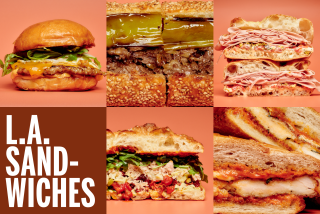Ways to Use Saffron, Safflower
- Share via
Question: I would like to know the difference between saffron and safflower. And what do these two herbs do in rice or other dishes?
Answer: Saffron (Crocus sativus) is a perennial with funnel-shaped blue or purple flowers that appear in autumn. Each flower has three orange stigmas, the source of the spice. Estimates vary, but it takes somewhere between 75,000 and 250,000 stigmas to produce one pound of saffron. Since these must be collected by hand, the spice is very expensive.
In “Herbs, Spices and Flavorings” (Overlook Press: 1982), author Tom Stobart writes, “Good saffron should not be more than a year old, of a brilliant orange color--not yellow, bleached or with white streaks--with a strong perfume and a pungent, bitter, medicinal, honey-like taste. In genuine saffron, the stigma expands immediately when a pinch is placed on the surface of warm water, and the color easily diffuses out. Cheap saffron does not exist, so any bargain should be suspect.”
Fortunately, it takes only a small amount of saffron to flavor and color food. The classic use is in bouillabaisse, but saffron is commonly used in fish soups and stews, breads, cakes and biscuits. The spice is used by some people for medicinal purposes and also produces a strong yellow dye.
Incidentally, the saffron crocus should not be confused with meadow saffron (Colchicum autumnale) a poisonous variety with pink flowers, each having six stamens.
The other herb, safflower (Carthamus tinctorius), is an annual that is not related to saffron. Safflower produces shaggy orange-yellow flowers used primarily to produce dyes for fabric and cosmetics. Although some people use an infusion from the flowers for medicinal purposes, Lesley Bremness, author of “The Complete Book of Herbs” (Viking Studio Books, 1988: $24.95) warns, “Do not take large amounts during pregnancy.”
Safflower is also cultivated for its seeds, which are pressed to produce oil. This is used for cooking, but the oil doesn’t impart any color to the food.
Q: Please tell me how one would use a square of bee’s honey comb. I received one and tried melting the honey and skimming off the wax. However, this method seems a waste of a lot of this pure honey. A friend of mine recommends just spreading the whole thing on bread and eating the wax right along with the honey. What to do?
A: Your friend is correct, the comb is edible. Comb honey is only available during certain times of the year. Cut comb is sometimes placed in jars, such as the one you received.
Q: I was raised in Hungary in the 1930s. The Dec. 8 Times Food Section feature on chestnuts brought to mind several desserts I remember being available in Hungarian pastry shops around the holidays.
One was called gestene pure. It consisted of fresh whipped cream and grated chestnuts. I have been searching high and low for a recipe for such a dish and am hoping that you can come up with it for me. I would be most grateful.
A: Sorry we didn’t make it in time for the holidays, but perhaps you will still enjoy knowing how to make this easy dessert. Sima Myaskovsky, owner of Alex & Ellas’s Continental Pastry Shop, 7356 Melrose Ave., Los Angeles, tells us you simply shred canned chestnut puree into a small dish, sprinkle it with a little rum and garnish with a generous dollop of whipped cream.
The shop sells canned chestnut puree imported from Switzerland, and French canned chestnut puree is available at specialty food stores.
Address questions on food preparation to You Asked About ..., Food Section, The Times, Times Mirror Square, Los Angeles 90053. Personal replies cannot be given.
More to Read
Eat your way across L.A.
Get our weekly Tasting Notes newsletter for reviews, news and more.
You may occasionally receive promotional content from the Los Angeles Times.










